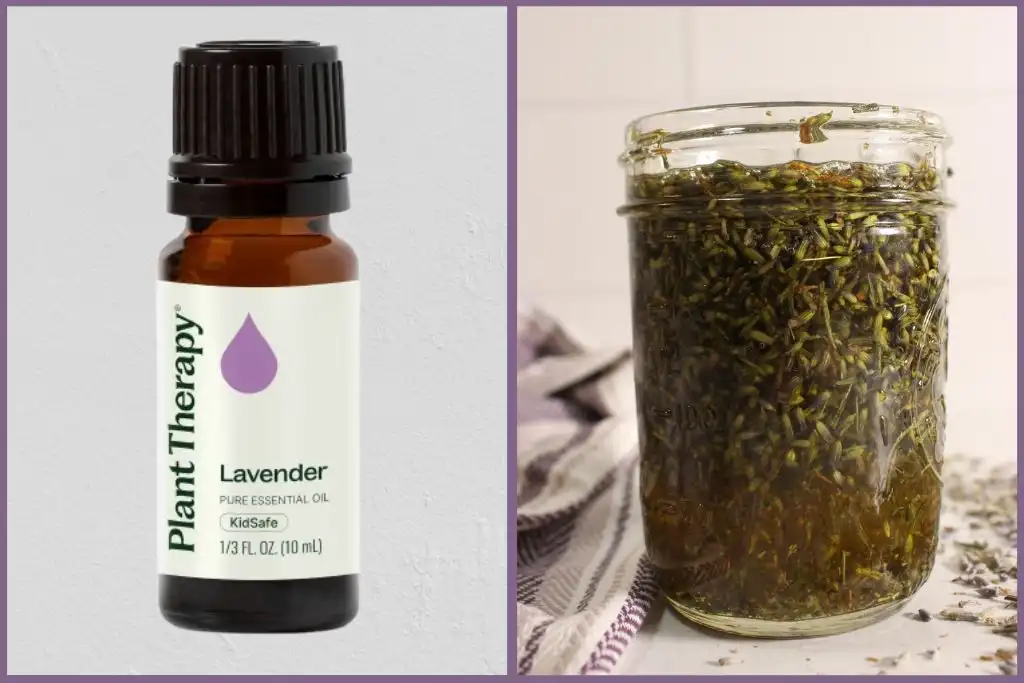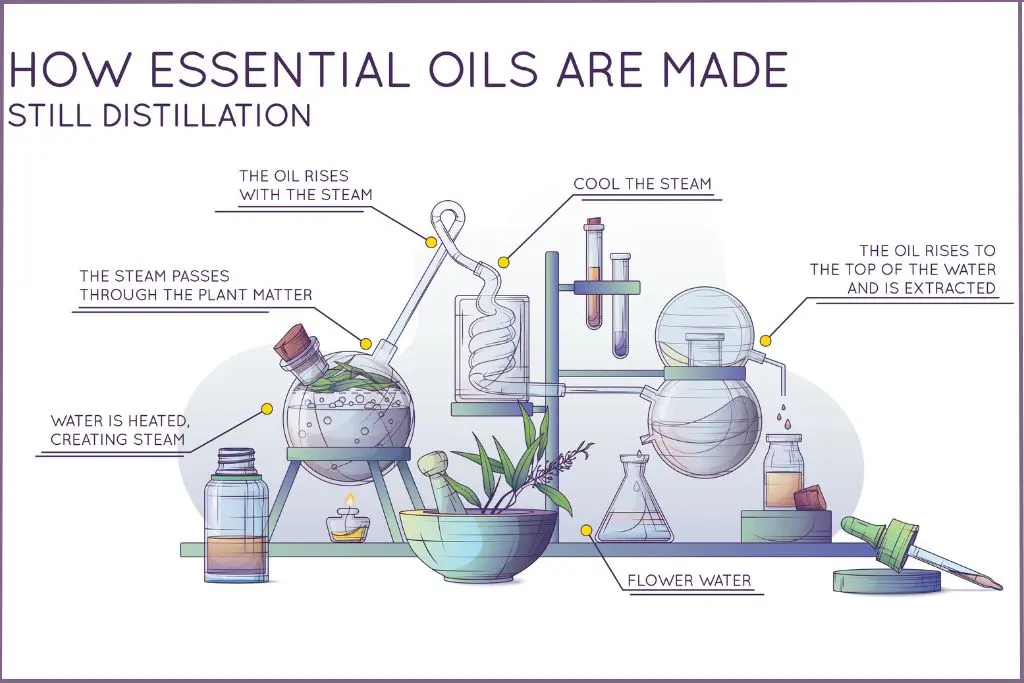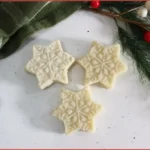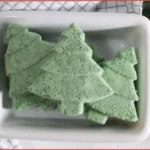Infused oils and essential oils are both aromatic oils produced from various plant parts. When it comes to essential oils vs infused oils, the similarities end there.
These two terms get tossed around interchangeably, but they are in fact two very different products with distinct uses in our daily routine.

✨ Get 12 Free Holiday Diffuser Blends — Printable PDF
Instantly make your home smell like Christmas with these festive, ready-to-use recipes.
Understanding the difference isn’t just about semantics. Infused oils are different from essential oils in almost all aspects, from their extraction methods to their properties, benefits, and applications.
Before using either type of plant oil, it helps to understand exactly what sets them apart, when to reach for each type, and how to build a collection that truly serves your wellness goals.
Table of Contents
Affiliate Disclosure: Some links on this site are affiliate links. I may earn a small commission if you purchase through them, at no extra cost to you. See the full affiliate disclosure.
What Are Essential Oils?
Essential oils are concentrated plant extracts that capture the aromatic compounds, or the essence, of various plant parts. Think of them as the concentrated personality of a plant, bottled up in liquid form.
What Are Infused Oils?
Infused oils take a completely different approach to capturing plant benefits. Instead of extracting concentrated compounds, infused oils involve steeping plant material in a carrier oil such as sweet almond oil, apricot oil, or jojoba oil to gently transfer some of the plant’s properties into the oil.
Producing herb-infused oils requires patience and time, as the oils need to infuse for several weeks to ensure maximum potency.
With a better understanding of what are infused oils and what are essential oils, here’s a more detailed breakdown of infused oils vs. essential oils in terms of their production process, safety, effectiveness, and traditional use.
Essential Oils Vs Infused Oils: Key Differences at a Glance
Let’s break down the main distinctions between these two types of oils:
| Basis of Differentiation | Essential Oils | Infused Oils |
| Production Method | Requires distillation equipment or cold-pressing machinery – cannot be made at home | Does not require any special equipment or machinery – can be made at home |
| Concentration | Highly Concentrated – a little goes a long way | Diluted & mild – applications require larger quantities |
| Aroma Strength | Have intense, pure scents that can fill a room | Have gentle aromas that are often barely noticeable |
| Shelf Life | Can last for years when stored properly | Depend on their carrier oil base and typically last 6-12 months |
| Application | Must be diluted before topical application | Can be applied to the skin directly without dilution |
| Cost | Are generally more expensive | Aee more affordable |
| Volume Needed for Applications | Typically requires a few drops for most applications | Generally measured by teaspoon or tablespoon for most applications |
Differences In Extraction Processes
Essential Oil Extraction Process

Essential oils are extracted through steam distillation or cold pressing. These methods capture only the volatile compounds of aromatic plants, resulting in potent oils that carry the distinct fragrance and properties of the source plant.
A significant amount of plant material, sometimes hundreds of pounds, is used to produce just one small bottle of essential oil. That’s why they are so concentrated and potent.
Extracting essential oils involves intensive processes that must be carried out under precise conditions. This is not a hobby project that can be done at home.
Infusion Process
Infused oils are created by steeping dried or fresh herbs, flowers, or other plant parts with a carrier oil, such as olive, coconut, or jojoba oil. The mixture is allowed to infuse for a period of time, after which the plant material is strained out.
This method allows the compounds from the plants to saturate the oil fully. The process is slow and gentle, as the oils need to infuse for several weeks for maximum potency.
Infusing herbs is not a precise process. It is easy to do at home with a few precautions.
Essential Oils Vs Infused Oils: Key Characteristics
Essential Oils
Essential oils are remarkable in their intensity. A single drop contains a powerful concentration of aromatic compounds. While this is great for aromatic purposes, it makes essential oils unsuitable for topical application without dilution.
They are also very volatile, evaporating quickly when exposed to air. This property makes them perfect for diffusing, but also means they need to be stored properly in dark glass bottles.
Infused oils are mild and ready to use straight from the bottle. Unlike essential oils, they’re already diluted. The carrier oil acts as the base, and the plant material simply adds subtle characteristics to it. The scent is gentle and often earthy or herbal rather than intensely aromatic.
These oils have a more limited shelf life than essential oils because the carrier oil can eventually go rancid. However, when stored properly in a cool, dark place, they can last for several months to a year, depending on the carrier oil used.
Essential Oils Vs Infused Oils: Concentration Of The Extract
Essential oils are highly concentrated and must be used sparingly. A little goes a long way. For topical applications, they must be diluted with a carrier oil.
Infused oils are mild and gentle enough to be applied to the skin directly. When applied topically, you get the benefits of the carrier oil as well as the plant extract.
Essential Oils Vs Infused Oils: Aroma Of The Extract
Essential oils are highly concentrated, requiring a large amount of plant material to produce a small quantity of oil. This concentration amplifies their aroma and therapeutic benefits.
Infused oils carry a more subtle scent compared to essential oils, as their aromatic compounds are not as concentrated. They primarily retain the properties of the infused plant material, offering a milder and more nourishing effect on the skin.
Essential Oils Vs Infused Oils: Skincare and Topical Application
Essential oils are known for their powerful scents and therapeutic properties. They can be used in aromatherapy to promote relaxation and uplift the mood. When properly diluted, essential oils can also be used to scent body care formulations.
Infused oils are popular in skincare routines due to their moisturizing, soothing, and healing properties. They can be used directly on the skin, providing hydration, nourishment, and promoting a healthy complexion. They also act as carriers for herbal constituents, allowing them to penetrate deeper into the body.
Essential Oils Vs Infused Oils: Aromatherapy Applications
Essential oils are commonly used in aromatherapy to promote relaxation, uplift mood, and refresh the atmosphere.
Infused oils have limited aromatherapy applications. They cannot be added to a diffuser, and inhaling the scent does nothing to enhance mood or promote relaxation.
Essential Oils Vs Infused Oils: Everyday Uses
Essential oils shine in aromatherapy diffusing, where their volatile nature helps scent fill a room. They’re also popular for creating custom blends, adding fragrance to unscented products like lotions or shampoos. Because they’re so concentrated, you only need a few drops in a diffuser or in DIY projects.
Special care must be taken to dilute essential oils in a carrier oil before topical application. They are too concentrated to apply to the skin directly.
Common uses for essential oils
- Diffusers for a clean, noticeable scent.
- Room sprays for a quick refresh.
- DIY candles or wax melts for bold fragrance.
- Scented sachets for closets or drawers.
Infused oils are wonderful for direct skin application in massage, body care routines, and bath oils. They’re gentle enough to use generously and don’t require further dilution. Many DIY beauty enthusiasts prefer them for making salves, balms, and lotions.
Common uses for infused oils:
- Body oil after a shower, fast and simple.
- Massage glide for a smooth, steady slip.
- Bath oil blend – add a spoonful to warm water.
- Hair oiling for ends or as a pre-wash oil.
- Soft-scent balms for hands or cuticles.
Essential Oils Vs Infused Oils: Differences In Packaging
Essential oils are packaged in smaller bottles as they are meant to be used very sparingly – just a few drops at a time. They must always be packaged in dark glass bottles to prevent premature damage due to exposure to sunlight.
Infused oils are generally packaged in larger bottles as they are meant to be applied generously over the skin. They may be stored in either dark or clear glass bottles.
Essential Oils Vs Infused Oils: Safety Considerations
Essential oils are highly concentrated and must be used with caution. They should be diluted in a carrier oil before application and should not be used on babies or during pregnancy for an extended period.
Infused oils are generally safe for direct application to the skin, making them more user-friendly and suitable for individuals with sensitive skin or those seeking a milder approach to skincare.
When to Choose Essential Oils
Essential oils are your go-to when you want concentrated aromatic benefits. They’re perfect for diffusing in your home or office, creating a specific ambiance with their powerful scents. A few drops in a diffuser can transform the energy of a space within minutes.
Essential oils also ideal when you’re making your own blends and want precise control over the aromatic profile. Creating a custom perfume, room spray, or scented product is where these extracts truly shine. You can mix and match to create exactly the scent combination you’re envisioning.
If you’re adding scent to unscented base products such as a plain lotion, unscented castile soap, or neutral carrier oil, essential oils provide that punch of aroma without adding much volume to your recipe.
Lastly, if you’re serious about aromatherapy and want a diverse aromatic palette to work with, essential oils offer an incredible range of scents that simply aren’t available as infused oils.
When to Choose Infused Oils
Infused oils are your best friend when you want something gentle and ready to use. They’re perfect for massage oils because you can apply them generously without worrying about concentration levels or skin sensitivity.
If you’re creating DIY beauty products and prefer a milder approach, infused oils bring both the carrier oil benefits and the subtle influence of the infused plant material. They work beautifully in body butters, balms, and facial oils where you want nourishing properties without strong scents.
For bath oils, infused oils are ideal because you can pour a generous amount into your tub without any concerns. They create a luxurious bathing experience with a subtle, spa-like quality.
If you have sensitive skin or prefer a gentler approach to plant-based wellness, infused oils offer a lower-risk way to enjoy botanical benefits. They’re also more forgiving for beginners who are still learning about dilution ratios and safe usage.
Infused oils are great for beginners, easy to clean up, and make thoughtful gifts.
Can Essential Oils & Infused Oils Work Together?
Absolutely! In fact, combining infused and essential oils can give you the best of both worlds. An infused oil can serve as a beautiful, specialized carrier oil for your essential oils, adding layers of interest to your blends.
For example, you might add a few drops of lavender essential oil to calendula-infused oil for a soothing massage blend. Or combine chamomile essential oil with coffee-infused oil for a richly aromatic body oil.
When creating facial serums, you might choose an infused oil as your base for its gentle properties, then add essential oils for their aromatic qualities and to create a product that feels luxurious and spa-worthy.
The key is understanding what each brings to the blend. The infused oil provides the base and mild plant characteristics, while the essential oil adds concentrated aroma and specific aromatic properties. Together, they create something more complex and interesting than either could alone.
Start with a plant-infused oil for feel, then add a tiny amount of essential oil for scent. Some beautiful combinations to try:
Calendula-infused oil + lavender essential oil: a calm, simple body oil.
Rosemary-infused oil + sweet orange essential oil: an uplifted, green-citrus hair oil for ends.
Jojoba infused with dried lavender + a hint of cedarwood essential oil: a cozy evening massage oil.
Making Your Own at Home
DIY Essential Oils
Creating true essential oils at home is more challenging and requires specialized equipment. You’d need a small still or distillation setup, which can be purchased online. The process involves steam distillation and takes several hours for even a small amount of oil.
For most people, purchasing quality essential oils from reputable suppliers makes more sense than trying to distill them at home. The investment in equipment, the quantity of plant material needed, and the time involved make home distillation more of a specialized hobby than a practical way to stock your aromatherapy cabinet.
However, if you’re fascinated by the process and want to try it, there are countertop stills available designed for beginners. Just understand that your yields will be small, and you’ll develop a deep appreciation for why essential oils cost what they do.
DIY Infused Oils
Making your own infused oils is satisfyingly simple and requires no special equipment. You can make them using the slower, cold infusion method or the faster, warm infusion method.
Always use dried plant material to prevent bacterial growth, label your oils with the date and contents, and store them in dark glass bottles in a cool location.
Essential Oils Vs. Infused Oils: Common Misconceptions
Misconception 1: Infused oils are just weak essential oils
This is completely untrue. They’re made through entirely different processes and are fundamentally different products. Infused oils aren’t diluted essential oils—they’re plant material steeped in carrier oil.
You can’t create an essential oil by concentrating an infused oil, and you can’t create an infused oil simply by diluting an essential oil.
Misconception 2: Essential oils and infused oils can be used interchangeably
Not at all. Using essential oils where a recipe calls for infused oils could result in skin irritation or an overpowering scent. Conversely, using infused oils where essential oils are specified won’t give you the aromatic intensity the recipe intends. They serve different purposes and should be used accordingly.
Misconception 3: All plant oils are basically the same
There’s a whole world of difference between essential oils, infused oils, and plain carrier oils (like jojoba or sweet almond oil). Each has its own production method, characteristics, and best uses. Lumping them all together as “plant oils” misses the nuance that makes each type special.
Marketing claims that blur the lines
Unfortunately, some products are marketed in confusing ways. You might see “essential oil blends” that are actually essential oils pre-diluted in carrier oils, or “infused oils” that are just carrier oils with essential oils added. Reading ingredient lists carefully helps you understand exactly what you’re buying.
Building Your Collection Of Plant Oils
Best Essential Oils For Beginners
If you’re just beginning your essential oil journey, start with these versatile favorites:
- Lavender: The most popular essential oil for good reason. It’s gentle, versatile, and has a universally appealing floral scent that works well in almost any blend.
- Peppermint: Crisp, refreshing, and energizing. Perfect for morning diffusing or adding to focus blends.
- Lemon: Bright, clean, and uplifting. A kitchen and cleaning favorite that blends beautifully with almost everything.
- Tea Tree: Distinctive and herbaceous, it’s a popular choice for skincare blends and household applications.
- Eucalyptus: Fresh, camphoraceous, and wonderful for creating spa-like experiences.
- These five give you a solid foundation for experimentation and will serve you well in countless applications.
Infused Oils Worth Having
For infused oils, consider starting with:
- Calendula-infused oil: Gentle and suitable for various skin applications, it’s a staple in many DIY beauty routines.
- Arnica-infused oil: Popular in massage oils and post-workout applications.
Creating a Balanced Collection
Think about your interests and lifestyle when building your collection. If you love diffusing, focus more on essential oils. If you’re into body care and massage, invest in good-quality infused and carrier oils.
Budget-wise, remember that essential oils go a long way—that $20 bottle might last you a year or more. Infused oils require larger quantities but are generally less expensive per ounce. Many people find that making their own infused oils at home is both economical and satisfying.
Don’t feel pressured to buy everything at once. Start with a few favorites and expand as you discover what you actually use and enjoy. Your collection should serve your real needs, not sit unused in a cupboard.
Essential oils and infused oils each have their unique place in a wellness-focused lifestyle. Essential oils bring concentrated aromatic power, perfect for diffusing, creating custom blends, and adding fragrance to your creations. Infused oils offer gentle, ready-to-use applications that work beautifully for massage, body care, and culinary adventures.
Neither is better than the other. They are simply different tools for different purposes. Understanding these differences empowers you to make informed choices, create more successful DIY projects, and use each type safely and effectively.
Frequently Asked Questions
Are infused oils as effective as essential oils?
There is no direct comparison. Each one is effective for different purposes. Essential oils excel at providing concentrated aroma for diffusing and scenting products. Infused oils are wonderful for gentle, direct application in body care. Neither is “better”. They simply serve different roles in your wellness routine.
Do infused oils smell as strong as essential oils?
No, infused oils have a much more subtle scent. If you’re looking for a strong aroma to fill a room, essential oils are your choice. If you want a gentle, barely-there scent for body care, infused oils are perfect.
Can I use essential oils directly on my skin like infused oils?
No. Essential oils are highly concentrated and must be diluted in a carrier oil before applying to the skin. Infused oils are already diluted and can be applied to the skin directly.
Which is better for beginners – essential oils or infused oils?
Infused oils are often more forgiving for beginners since they’re pre-diluted and ready to use. Essential oils require learning about dilution ratios and safe usage practices.
That said, many beginners start with both, using essential oils for diffusing and infused oils for body care.




